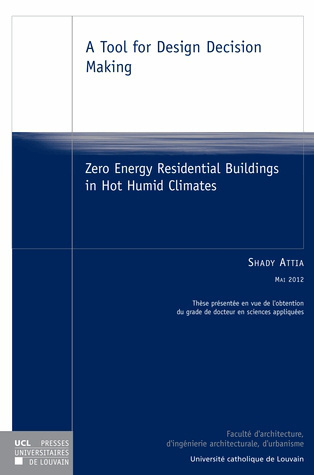A Tool for Design Decision Making
Zero Energy Residential Buildings in Hot Humid Climates
Première édition
This thesis investigates the use of building performance simulation tools as a method of informing the design decision of Net Zero Energy Buildings (NZEBs). Lire la suite
Informed decision-making is the basis for the design of Net Zero Energy Buildings
(NZEBs). This thesis investigates the use of building performance simulation tools
as a method of informing the design decision of NZEBs. The aim of this
Informed decision-making is the basis for the design of Net Zero Energy Buildings (NZEBs). This thesis investigates the use of building performance simulation tools as a method of informing the design decision of NZEBs. The aim of this study was to develop a design decision making tool, ZEBO, for zero energy residential buildings informed decision-making using sensitivity analysis. An assessment of the role of the BPS tools used in informing the decision-making was ascertained through cases studies, usability testing and several self-reported metrics. The thesis provides results that shed light on the effectiveness of sensitivity analysis as an approach for informing the design decisions of NZEBs.
Spécifications
- Éditeur
- Presses universitaires de Louvain
- Partie du titre
-
Numéro 4
- Partie du titre
-
Volume 4
- Auteur
- Shady Attia,
- Collection
- Thèses de la Faculté d'architecture, d'ingénierie architecturale, d'urbanisme
- Langue
- anglais
- Catégorie (éditeur)
- Sciences appliquées > Architecture et génie civil
- Catégorie (éditeur)
- Sciences appliquées > Urbanisme et développement territorial
- BISAC Subject Heading
- ARC000000 ARCHITECTURE
- Code publique Onix
- 06 Professionnel et académique
- CLIL (Version 2013-2019 )
- 3076 Architecture/Urbanisme
- Description public visé
- Architectes (climatiques)
- Date de première publication du titre
- 01 mai 2012
- Subject Scheme Identifier Code
- Classification thématique Thema: Aménagement et politique des villes et villages
- Type d'ouvrage
- Thèse
Livre broché
- Date de publication
- 01 mai 2012
- ISBN-13
- 978-2-87558-059-7
- Ampleur
- Nombre de pages de contenu principal : 298
- Dépôt Légal
- D/2011/9964/15 Louvain-la-Neuve, Belgique
- Code interne
- 86271
- Format
- 16 x 24 x 1,7 cm
- Poids
- 482 grammes
- Prix
- 46,00 €
- ONIX XML
- Version 2.1, Version 3
Google Livres Aperçu
Publier un commentaire sur cet ouvrage
Si vous avez une question, utilisez plutôt notre formulaire de contact
Sommaire
Chapter 1 .. Introduction 5
1.1 NZEB DESIGN 5
1.2 THEORETICAL AND CONCEPTUAL BACKGROUND 9
1.3 RESEARCH QUESTIONS OF THE THESIS 10
1.4 THESIS OUTLINE 12
Part I • Analysis of NZEB Design Problem 15
Chapter 2 ... Hot Humid Climate & Comfort 17
2.1 INTRODUCTION 17
2.2 HOT AND HUMID CLIMATES 17
2.3 RESIDENTIAL BUILDINGS ENERGY PERFORMANCE 22
2.4 THERMAL COMFORT IN HOT CLIMATES 25
2.5 BIOCLIMATIC ANALYSIS METHODS 32
2.6 EVALUATION CRITERIA OF THERMAL COMFORT 38
2.7 CONCLUSION 39
Chapter 3 .. Design & Practice of NZEB 41
3.1 INTRODUCTION 41
3.2 DEFINITION OF NZEB 41
3.3 DESIGN CONCEPTS OF NZEB FOR HOT CLIMATES 44
3.4 PASSIVE, LOW ENERGY AND HYBRID COOLING STRATEGIES 47
3.5 SCALE AND URBAN DENSITY 51
3.6 HIGH TECH OR LOW TECH NZEBS 53
3.7 DESIGN METHODOLOGY AND GUIDANCE 56
3.8 CONCLUSION 63
Chapter 4 .. Design & Technologies of NZEB 65
4.1 INTRODUCTION 66
4.2 ACTIVE VENTILATION TECHNOLOGIES 67
4.3 ACTIVE COOLING TECHNOLOGIES 70
4.4 SOLAR RENEWABLE TECHNOLOGIES 76
1
4.5 SOLAR COOLING TECHNOLOGIES 81
4.6 PARAMETRIC ANALYSIS AND A NZEB CASE STUDY 82
4.7 CONCLUSION 89
Chapter 5 .. Design & Modelling of NZEB 91
5.1 INTRODUCTION 91
5.2 BUILDING PERFORMANCE SIMULATION FOR NZEBS 92
5.3 DESIGN PROCESS AND TOOLS OF NZEB 94
5.4 NZEBS TOOLS REVIEW 98
5.5 BPS FOR ARCHITECTS' DECISION SUPPORT 111
5.6 CONCLUSION 114
CONCLUSION OF PART I 115
Part II • Development of the Decision Aid 117
Chapter 6 .. Towards a NZEB Decision Support Tool 119
6.1 INTRODUCTION 119
6.2 BACKGROUND 120
6.3 STRUCTURE OF THE WORKSHOPS 121
6.4 RESULTS OF THE WORKSHOPS 123
6.5 DISCUSSION 132
6.6 CONCLUSION 136
Chapter 7 .. Development of Benchmark 139
7.1 INTRODUCTION 139
7.2 LITERATURE REVIEW 142
7.3 METHODOLOGY 145
7.4 SURVEY RESULTS 149
7.5 DISCUSSION 160
7.6 CONCLUSION 163
Chapter 8 .. Development of the Decision Support Tool 165
8.1 INTRODUCTION 166
8.2 TOOL DESCRIPTION 166
2
8.3 CASE STUDY 173
8.4 USABILITY TESTING 177
8.5 DISCUSSION AND CONCLUSION 182
CONCLUSION OF PART II 185
Part III • Evaluation of the Decision Aid 187
Chapter 9.. Design Case Studies 189
9.1 INTRODUCTION 189
9.2 CASE STUDY 1 189
9.3 CASE STUDY 2 192
9.4 CASE STUDY 3 197
9.5 CONCLUSION 201
Chapter 10 .. Usability Testing & Validation 203
10.1 INTRODUCTION 203
10.2 DESIGNING AND CONDUCTING THE STUDY 204
10.3 CASE STUDIES FRAMEWORK 207
10.4 RESULTS 207
10.5 DISCUSSION AND CONCLUSION 219
CONCLUSION OF PART III 221
Chapter 11 .. Conclusions 223
11.1 INTRODUCTION 223
11.2 PRINCIPAL FINDINGS 223
11.3 INTERPRETATION AND CRITIQUE OF THE FINDINGS 225
11.4 FUTURE WORK 230
11.5 CONCLUSION 231
References 233
Abbreviations and Acronyms 251
Appendix A 253
Appendix B 263
Appendix C 270
3
Appendix D 278
List of Figures 280
Summary 285
Acknowledgements 289
Bibliography 291
Selected Publications 292

